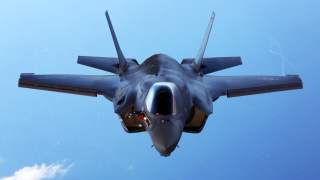Russia and China Have Plans to Make Sure They Can Fight America (And Win)
“The security environment is becoming more complex with our adversaries’ determined pursuit of advanced technologies across multiple domains."
The post-Cold War unipolar moment of American military dominance is over. Instead, the United States increasingly faces a multipolar world where peer-level competitors have military capability that increasing match Washington’s own.
“The military environment has shifted from the existence of the United States as the single power able to dominate challengers and to deter aggression through conventional means to one in which foreign militaries are emerging with near-peer and, in some areas, peer capabilities,” Defense Intelligence Agency director Lt. Gen. Robert Ashley testified before the Senate Armed Services Committee on March 6.
“Adversaries have studied the American way of conflict and have developed, and will continue to develop, capabilities to mitigate or upend longstanding U.S. military dominance in all warfighting domains—terrestrial, maritime, air, space, and cyber—raising the complexity of the threat environment and risk to the United States. Competitor states will employ all diplomatic, economic, political, and covert mechanisms of influence and coercion available to advance their agendas. Many states will continue to view nuclear weapons as both the guarantor of regime survival and a critical capability in a conflict with a conventionally superior adversary.”
Recommended: Stealth vs. North Korea’s Air Defenses: Who Wins?
Recommended: America’s Battleships Went to War Against North Korea
Recommended: 5 Places World War III Could Start in 2018
As one might expect, the two main threats are Russia and China.
“China and Russia present the greatest threat of developing new military capabilities using emerging and disruptive technologies,” Ashley said. “Major military powers will continue to emphasize development of more capable ballistic and cruise missiles. China’s People’s Liberation Army (PLA) is developing and fielding numerous advanced, long-range land-attack and anti-ship cruise missiles, some capable of reaching supersonic speeds, operated from ground, air, ship, and submarine platforms. Developments in hypersonic propulsion will revolutionize warfare by providing the ability to strike targets more quickly, at greater distances, and with greater firepower. China is also developing increasingly sophisticated ballistic missile warheads and hypersonic glide vehicles in an attempt to counter ballistic missile defense systems. Russia claims a new class of hypersonic glide vehicle under development will allow Russian strategic missiles to penetrate missile defense systems. Iran is pursuing long-range, precision land-attack cruise missiles as well as development of more powerful space launch vehicles—boosters that would be capable of ICBM ranges if configured for that purpose.”
Additionally, new technological advances are eroding America’s traditional military dominance that it has held since the 1991 collapse of the Soviet Union. “Developments in novel materials will enable operations in extreme environments. Advances in photonics will permit significant improvements in military communications, remote sensing, navigation, stealth, and directed-energy weapons,” Ashley said. “The IoT [internet of Things] will offer advanced connectivity to devices, systems, sensors, and services. Atomic sensors will allow for navigation in GPS-denied and electronic warfare environments. The rapid development of cyber technologies, particularly quantum technologies, IoT, supercomputers, and artificial intelligence, is enabling new defensive and offensive military capabilities. Adversaries are giving priority to researching quantum-enabled communications and quantum computing, which could supply the means to field highly secure communication systems and eventually to break certain encryption algorithms. The challenge for predicting the next emerging and disruptive technology for the future is anticipating the follow-on effects of seemingly innocuous technologies that are evolving today.”
Ashley offered some sobering conclusions. “The security environment is becoming more complex with our adversaries’ determined pursuit of advanced technologies across multiple domains to include cyber, space, and WMD [weapons of mass destruction], expanding regional and global ambitions and the serious, persistent threat from terrorism,” Ashley said. “These risks pose an increasing challenge to our warfighters, decisionmakers, and the Intelligence Community.”
Dave Majumdar is the defense editor for The National Interest. You can follow him on Twitter: @davemajumdar.

